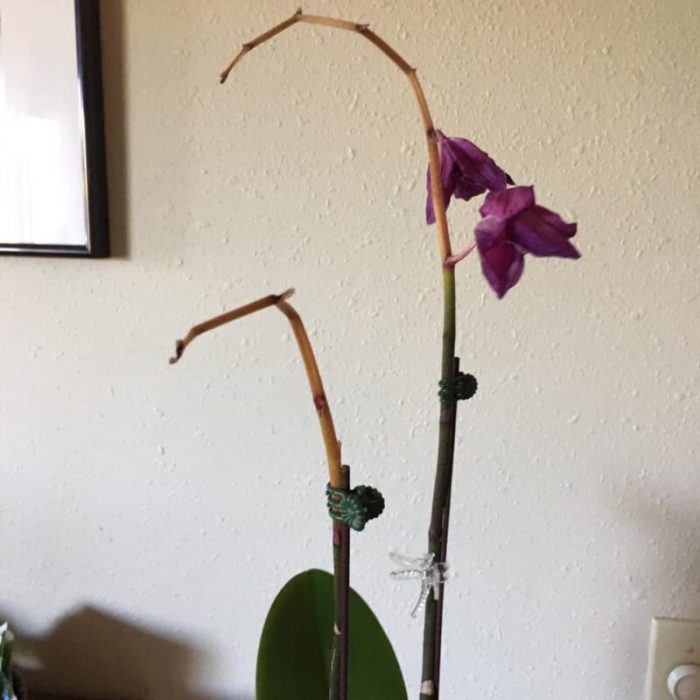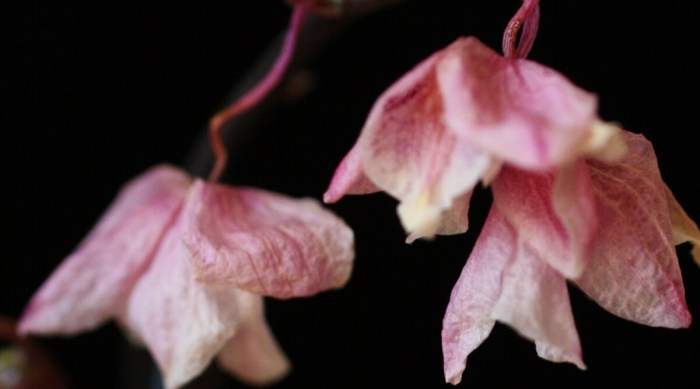Watering and Orchid Flower Loss: Orchid Plant Losing Flowers

Orchid plant losing flowers – Proper watering is crucial for orchid health and flower longevity. Incorrect watering practices, whether underwatering or overwatering, are significant contributors to premature flower drop and overall plant decline. Understanding the specific needs of different orchid types is key to preventing these issues.Optimal Watering Techniques for Various Orchid TypesDifferent orchid species have varying water requirements based on their natural habitats.
Phalaenopsis orchids, for instance, prefer consistently moist but not soggy roots, while Cattleya orchids require a period of drying between waterings. Dendrobium orchids have diverse needs depending on the specific species, with some preferring drier conditions than others. Ignoring these differences can lead to significant problems.
Signs of Underwatered and Overwatered Orchids
Underwatering manifests as shriveled leaves, pseudobulbs that feel soft and wrinkled, and premature flower drop. The plant may appear generally wilted and lackluster. Conversely, overwatering leads to yellowing and browning leaves, root rot (evident as mushy, dark roots), and a foul odor emanating from the potting medium. Flowers on an overwatered orchid will often drop prematurely. The potting mix will remain consistently wet.
Watering Schedules for Different Orchid Species
A rigid schedule isn’t ideal; adjust watering based on the orchid’s needs and environmental conditions. Phalaenopsis orchids might need watering every 7-10 days in average indoor conditions, while Cattleyas may only need watering every 10-14 days or even less frequently. Dendrobium species vary greatly; some might need weekly watering during active growth, while others are more drought-tolerant. Always check the potting mix’s moisture level before watering.
If the mix is still damp, wait before watering again.
Appropriate Watering Methods
Soaking is an effective method for many orchid types. Submerge the pot in lukewarm water for 10-15 minutes, allowing the potting mix to absorb water thoroughly. This ensures even hydration. Ensure excess water drains completely to prevent root rot. Misting is beneficial for increasing humidity around the plant, particularly for species that appreciate higher humidity levels, but it shouldn’t replace thorough watering.
Orchid plants losing their flowers is a common issue, often stemming from improper care. Sometimes, however, the vibrant display of a different plant can offer a welcome distraction; for instance, the striking beauty of a plant with yellow trumpet flowers can be quite captivating. Returning to orchids, understanding their specific needs, such as consistent watering and appropriate lighting, is crucial to preventing premature flower drop.
It can help maintain moisture levels between waterings, especially during dry conditions.
Light and Orchid Bloom Duration

Orchids, known for their exquisite blooms, have varying light requirements depending on their species and origin. Understanding these needs is crucial for maximizing flower production and longevity. Providing the correct amount of light is essential for healthy growth and abundant flowering, while incorrect lighting can lead to stunted growth and premature flower drop.
The intensity and type of light significantly influence orchid flowering. Insufficient light often results in weak, leggy growth and a lack of blooms. Conversely, excessive light, particularly direct intense sunlight, can scorch leaves and damage flowers, shortening their lifespan. Different orchid varieties have evolved to thrive under specific light conditions, mirroring their natural habitats.
Ideal Light Conditions for Various Orchid Types
The ideal light intensity for orchids is generally measured in terms of light levels or the percentage of full sunlight. Different orchid genera have evolved to tolerate different light intensities. Phalaenopsis orchids, for instance, prefer lower light levels, while Cattleya orchids generally need more light. It is important to note that these are general guidelines, and the specific light requirements can vary even within a single species based on factors like the plant’s age and overall health.
| Orchid Type | Light Intensity | Light Source Examples |
|---|---|---|
| Phalaenopsis (Moth Orchids) | Low to Medium (50-70% shade) | East-facing window, filtered sunlight, fluorescent lights |
| Cattleya | Medium to High (60-80% sunlight) | South or West-facing window (with shade during peak sun hours), grow lights |
| Dendrobium | Medium to High (60-80% sunlight) | Bright, indirect light; south or west-facing window (with afternoon shade) |
| Oncidium (Dancing Lady Orchids) | Medium to High (60-80% sunlight) | Bright, indirect light; east or south-facing window (with shade during midday) |
Effects of Insufficient and Excessive Light on Orchid Flower Development
Insufficient light leads to weak, etiolated growth (long, spindly stems) in orchids, delaying or preventing flowering. Leaves may appear pale green or yellow. Flowers, if produced, may be smaller and fewer in number and have a shorter lifespan. Excessive light, on the other hand, causes leaf scorch, evidenced by brown or bleached patches on the leaves. Flowers exposed to intense sunlight can become sunburnt and wither prematurely.
The plant may also exhibit signs of stress, such as leaf drop.
Direct Sunlight versus Filtered Light on Orchid Flower Retention
Direct sunlight, especially during the hottest part of the day, is detrimental to most orchids. The intense UV radiation can damage leaf and flower tissues, leading to scorching and premature flower drop. Filtered light, such as that provided by a sheer curtain or a lightly shaded location, is far more beneficial. It allows sufficient light for photosynthesis while protecting the plants from the harmful effects of direct sunlight.
This results in healthier plants with longer-lasting blooms.
Orchid Repotting and Flower Drop

Repotting orchids, while a necessary task for their long-term health, can unfortunately trigger flower loss if not done correctly. Understanding the delicate balance of root health and the orchid’s flowering cycle is crucial to minimize this risk. Improper techniques can damage the roots, leading to stress that causes the plant to prematurely drop its blooms as it prioritizes survival.Orchid repotting is essential for providing a fresh, well-draining potting medium and allowing for root growth.
Over time, the old potting mix breaks down, becoming compacted and losing its ability to provide adequate aeration and drainage. This can lead to root rot, a major cause of orchid decline and flower loss. Conversely, a healthy root system is fundamental to the orchid’s ability to absorb nutrients and water, ultimately supporting robust flowering.
Root Damage During Repotting and Flower Loss
Root damage during repotting is a significant contributor to flower drop. The orchid’s roots are extremely fragile and easily broken or bruised. Even minor damage can disrupt the plant’s water and nutrient uptake, triggering stress that results in the plant shedding its flowers to conserve energy. This stress response prioritizes the plant’s survival over continued flowering. Carefully handling the roots during repotting is paramount to prevent this.
Ideal Potting Mix Components and Their Impact
The ideal orchid potting mix is well-draining and airy, mimicking the orchids’ natural epiphytic environment. It should consist of a blend of materials that provide both support and drainage. Common components include bark chips (fir bark is popular), perlite, charcoal, and sphagnum moss. Bark provides structure and drainage, perlite enhances aeration, charcoal improves drainage and prevents fungal growth, and sphagnum moss retains some moisture.
The exact proportions can vary depending on the specific orchid species and its growth habits, but the overall goal is a mix that is not overly wet or compact. A poorly draining mix leads to root rot and subsequent flower loss.
Step-by-Step Repotting of Orchids, Orchid plant losing flowers
Before beginning, gather the necessary materials: a new pot (slightly larger than the old one), fresh orchid potting mix, and sharp, clean scissors or pruning shears.
- Gently remove the orchid from its old pot. Avoid pulling forcefully; instead, gently loosen the roots around the pot’s edges and carefully tip the plant out. If the roots are tightly bound, you can gently tease them apart.
- Inspect the roots. Carefully examine the roots, removing any that are dead, mushy, or severely damaged using the clean scissors. Healthy roots are firm and silvery-green.
- Prepare the new pot. Place a layer of fresh potting mix at the bottom of the new pot.
- Position the orchid. Place the orchid in the new pot, ensuring the crown (where the leaves emerge from) is at the same level as it was in the old pot. Avoid planting it too deeply, as this can lead to root rot.
- Fill the pot with potting mix. Gently fill the pot with the fresh potting mix, ensuring the roots are evenly distributed and not tightly packed. Leave some space at the top of the pot for watering.
- Water lightly. After repotting, water lightly to settle the potting mix. Avoid overwatering, as this can contribute to root rot.
Question Bank
Can repotting cause orchids to lose flowers?
Yes, improper repotting can damage roots, leading to stress and flower drop. Gentle handling and using the correct potting mix are crucial.
How often should I fertilize my orchids?
Fertilize during active growth periods (spring and summer) with a balanced orchid fertilizer, following the product instructions. Reduce or cease fertilization during dormancy.
What’s the best way to increase humidity for orchids?
Group plants together, use a pebble tray with water, or invest in a humidifier. Regular misting can also help, but avoid wetting the flowers.
My orchid’s flowers are dropping, but the leaves look healthy. What could be wrong?
This could indicate a sudden change in environment (temperature, light, or humidity). Check for these factors and adjust accordingly.
